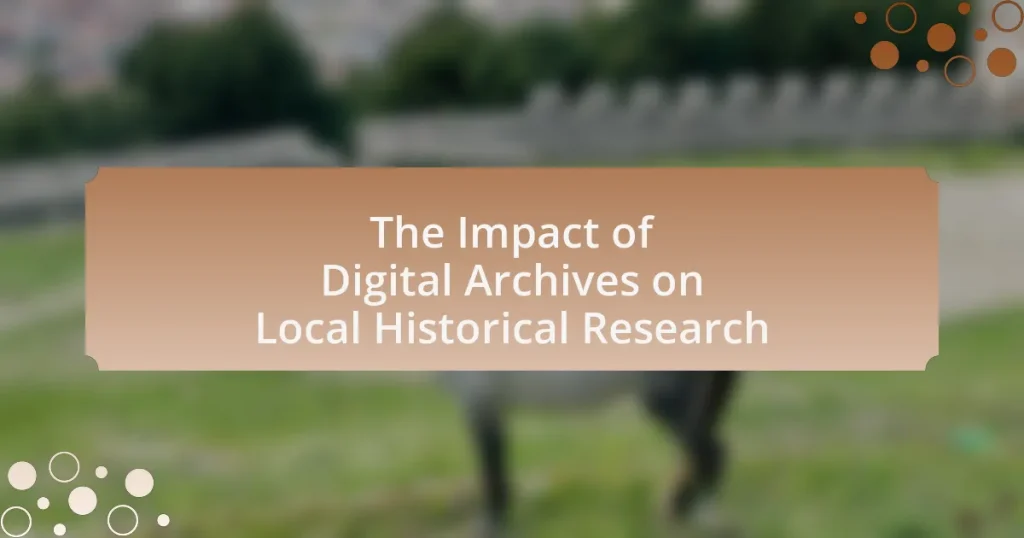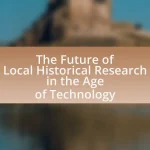Digital archives are collections of digitized documents, records, and artifacts that enhance accessibility and preservation for historical research. They differ from traditional archives by providing remote access to a wide range of primary sources, such as text documents, images, and audio recordings, which facilitates local historical research. The article explores the technologies enabling digital archiving, the importance of digitization for preserving historical documents, and the advantages and limitations of digital archives for local historians. Additionally, it discusses future trends in digital archiving, best practices for researchers, and the impact of artificial intelligence on improving access and engagement with historical materials.
What are Digital Archives and Their Role in Historical Research?
Digital archives are collections of digitized documents, records, and artifacts that are preserved and made accessible online for research and educational purposes. Their role in historical research is significant, as they provide researchers with easy access to primary sources, enhance the preservation of historical materials, and facilitate the sharing of information across geographical boundaries. For instance, the National Archives in the United States has digitized millions of documents, allowing historians to access vital records that were previously only available in physical form. This accessibility accelerates research processes and encourages collaboration among scholars, ultimately enriching the understanding of historical contexts and narratives.
How do digital archives differ from traditional archives?
Digital archives differ from traditional archives primarily in their format and accessibility. Digital archives store information in electronic formats, allowing for easier retrieval and sharing, while traditional archives typically consist of physical documents and artifacts that require in-person access. The shift to digital formats enables broader access to historical materials, as users can access them remotely via the internet, which is not possible with physical archives that necessitate on-site visits. This increased accessibility can significantly enhance local historical research by providing researchers with immediate access to a wider range of resources, thus facilitating more comprehensive studies.
What technologies enable the creation of digital archives?
Technologies that enable the creation of digital archives include digitization tools, database management systems, and cloud storage solutions. Digitization tools, such as scanners and imaging software, convert physical documents into digital formats, making them accessible and easier to preserve. Database management systems, like MySQL and MongoDB, organize and store digital content, allowing for efficient retrieval and management of archival materials. Cloud storage solutions, such as Amazon Web Services and Google Cloud, provide scalable and secure environments for storing large volumes of digital archives, ensuring data integrity and accessibility over time. These technologies collectively enhance the preservation and accessibility of historical records, facilitating local historical research.
Why is digitization important for preserving historical documents?
Digitization is important for preserving historical documents because it ensures their accessibility and longevity. By converting physical documents into digital formats, the risk of deterioration from environmental factors, handling, and time is significantly reduced. For instance, the Library of Congress has digitized millions of documents, allowing broader public access while protecting the originals from wear and tear. This process not only safeguards the content but also enhances research opportunities, as digital archives can be easily searched and shared, facilitating local historical research and education.
What types of materials are commonly found in digital archives?
Digital archives commonly contain a variety of materials, including text documents, images, audio recordings, video files, and datasets. These materials serve as primary sources for research and preservation of historical records. For instance, text documents may include letters, manuscripts, and reports, while images can encompass photographs, maps, and illustrations. Audio and video files often consist of oral histories and recorded events, providing rich context for researchers. Datasets may include statistical information and research findings relevant to historical studies. The diversity of these materials enhances the depth and breadth of local historical research, allowing for comprehensive analysis and understanding of historical contexts.
How do local historical documents contribute to community identity?
Local historical documents significantly contribute to community identity by preserving and reflecting the unique narratives, traditions, and experiences of a community. These documents, such as letters, photographs, and official records, serve as tangible connections to the past, allowing residents to understand their heritage and cultural roots. For instance, a community’s founding documents can highlight its values and aspirations, fostering a sense of belonging among its members. Additionally, studies have shown that communities with access to their historical records exhibit stronger social cohesion and pride, as these documents reinforce shared histories and collective memory.
What are the challenges in digitizing local historical materials?
The challenges in digitizing local historical materials include issues related to funding, technical expertise, and preservation of the original materials. Funding is often limited, making it difficult to acquire the necessary technology and resources for digitization projects. Technical expertise is required to ensure that the digitization process maintains the integrity and quality of the historical materials, which can be lacking in local institutions. Additionally, preserving the original materials during the digitization process poses a challenge, as improper handling can lead to deterioration. These challenges are documented in studies such as “The Digital Preservation of Cultural Heritage” by the Library of Congress, which highlights the importance of addressing these barriers to effectively digitize and preserve local historical materials.
How do Digital Archives Impact Local Historical Research?
Digital archives significantly enhance local historical research by providing accessible, organized, and searchable collections of historical documents and artifacts. These archives allow researchers to easily locate primary sources, such as photographs, letters, and official records, which are crucial for understanding local history. For instance, the Digital Public Library of America offers access to millions of photographs and documents that can be used to study regional developments and events. Furthermore, digital archives often include metadata that facilitates efficient searches, enabling researchers to uncover connections and insights that may have been difficult to find in traditional physical archives. This accessibility democratizes historical research, allowing a broader audience to engage with local history, as evidenced by increased participation in community history projects and local heritage initiatives.
What advantages do digital archives provide to local historians?
Digital archives provide local historians with enhanced accessibility to historical documents, allowing them to conduct research more efficiently. These archives often contain digitized primary sources, such as photographs, letters, and official records, which can be accessed remotely, eliminating the need for physical travel to archives. For instance, the National Archives in the United States has digitized millions of documents, making them available online, which significantly broadens the scope of research for local historians. Additionally, digital archives often include advanced search functionalities, enabling historians to quickly locate specific information within vast collections, thus saving time and increasing productivity in their research efforts.
How do digital archives enhance accessibility for researchers?
Digital archives enhance accessibility for researchers by providing online access to a vast array of historical documents and resources. This online availability allows researchers to easily locate, retrieve, and analyze materials that may have been previously difficult to access due to geographical or physical constraints. For instance, the Digital Public Library of America offers millions of photographs, manuscripts, and other resources, enabling researchers to conduct comprehensive studies without the need for travel. Additionally, digital archives often include advanced search functionalities, which facilitate efficient information retrieval, further supporting researchers in their work.
What role do digital archives play in collaborative research efforts?
Digital archives serve as essential resources in collaborative research efforts by providing accessible, organized, and searchable collections of historical documents and data. These archives facilitate the sharing of information among researchers, enabling them to collaborate more effectively across geographical and disciplinary boundaries. For instance, the Digital Public Library of America offers a vast repository of digitized materials that researchers can access simultaneously, fostering teamwork and enhancing the quality of research outputs. Furthermore, studies have shown that collaborative projects utilizing digital archives often yield richer insights and more comprehensive analyses, as evidenced by the successful outcomes of initiatives like the Europeana project, which aggregates cultural heritage content from across Europe for collaborative use.
What limitations exist within digital archives for local historical research?
Digital archives for local historical research face several limitations, including incomplete collections, lack of context, and accessibility issues. Incomplete collections arise because not all historical documents have been digitized, leading to gaps in available information. For instance, many local records, such as municipal documents or personal letters, may remain in physical form, limiting researchers’ access to comprehensive data.
Additionally, the lack of context in digital archives can hinder understanding; documents may be presented without sufficient background information, making it difficult for researchers to interpret their significance accurately. Furthermore, accessibility issues can arise from technological barriers, such as the need for specific software or hardware to access certain archives, which can exclude some researchers from utilizing these resources effectively.
These limitations highlight the challenges faced in leveraging digital archives for thorough local historical research.
How can the quality of digitized materials affect research outcomes?
The quality of digitized materials significantly affects research outcomes by influencing the accuracy and reliability of the information accessed. High-quality digitized materials, characterized by clear images, accurate metadata, and comprehensive indexing, enable researchers to locate relevant data efficiently and draw valid conclusions. Conversely, low-quality digitized materials can lead to misinterpretations, incomplete analyses, and ultimately flawed research findings. For instance, a study published in the Journal of Digital Humanities highlights that researchers using high-resolution scans of historical documents were able to uncover details that were missed in lower-quality versions, demonstrating the direct correlation between material quality and research depth.
What are the potential biases in digital archiving practices?
Potential biases in digital archiving practices include selection bias, representation bias, and preservation bias. Selection bias occurs when certain materials are chosen for digitization based on subjective criteria, often favoring dominant narratives while excluding marginalized voices. Representation bias arises when the digitized content does not accurately reflect the diversity of the original materials, leading to an incomplete historical record. Preservation bias happens when the focus on preserving certain formats or types of content results in the neglect of others, which can distort the historical context. These biases can significantly impact local historical research by shaping the narratives that are accessible and influencing the understanding of community histories.
What Future Trends Can Be Expected in Digital Archiving for Local History?
Future trends in digital archiving for local history include increased use of artificial intelligence for data organization, enhanced accessibility through cloud storage, and the integration of augmented reality for immersive experiences. These advancements will streamline the archiving process, making it easier for researchers and the public to access historical documents and artifacts. For instance, AI can automate the categorization of vast amounts of data, while cloud storage solutions allow for remote access, ensuring that local history is preserved and shared widely. Additionally, augmented reality applications can provide interactive experiences that engage users with local history in a dynamic way, as seen in projects like the “Augmented Reality for Cultural Heritage” initiative, which demonstrates the potential for technology to enhance historical understanding.
How is technology evolving to improve digital archives?
Technology is evolving to improve digital archives through advancements in artificial intelligence, machine learning, and cloud storage solutions. These technologies enhance the organization, accessibility, and preservation of archival materials. For instance, AI-driven tools can automate the cataloging process, making it faster and more accurate, while machine learning algorithms can analyze large datasets to identify patterns and relationships within historical documents. Additionally, cloud storage provides scalable solutions for storing vast amounts of data, ensuring that digital archives are secure and easily accessible from anywhere. This evolution is supported by studies showing that AI can increase the efficiency of archival processes by up to 70%, thereby significantly benefiting local historical research.
What innovations are being developed for better user engagement?
Innovations being developed for better user engagement in the context of digital archives include interactive interfaces, personalized content recommendations, and enhanced search functionalities. Interactive interfaces allow users to explore historical data through visualizations and multimedia elements, making the experience more engaging. Personalized content recommendations utilize algorithms to suggest relevant materials based on user behavior, increasing the likelihood of user interaction. Enhanced search functionalities, such as natural language processing and advanced filtering options, improve the accessibility of information, allowing users to find specific historical documents more efficiently. These innovations are supported by research indicating that user engagement increases when digital platforms offer tailored experiences and intuitive navigation.
How might artificial intelligence influence the future of digital archiving?
Artificial intelligence will significantly enhance the future of digital archiving by automating the organization, retrieval, and preservation of digital assets. AI technologies, such as machine learning and natural language processing, can analyze vast amounts of data quickly, enabling more efficient categorization and tagging of archival materials. For instance, AI can automatically transcribe handwritten documents, making them searchable and accessible, which is crucial for local historical research. Additionally, AI algorithms can identify patterns and connections within archival data, facilitating deeper insights into historical contexts. Studies have shown that AI-driven tools can reduce the time spent on manual archiving tasks by up to 70%, thereby increasing the overall efficiency and effectiveness of digital archiving efforts.
What best practices should local historians follow when using digital archives?
Local historians should follow best practices such as verifying the credibility of digital archives, utilizing metadata effectively, and ensuring proper citation of sources. Verifying the credibility involves assessing the institution behind the archive, as reputable organizations like national libraries or universities typically provide reliable information. Utilizing metadata effectively allows historians to understand the context and provenance of the materials, which is crucial for accurate interpretation. Proper citation of sources is essential for maintaining academic integrity and enabling others to trace the origins of the information used in their research. These practices enhance the reliability and scholarly value of local historical research conducted through digital archives.
How can researchers ensure they are using reliable digital sources?
Researchers can ensure they are using reliable digital sources by evaluating the credibility of the source, checking the author’s qualifications, and verifying the information against other reputable references. Credible sources typically come from established institutions, peer-reviewed journals, or recognized experts in the field. For instance, a study published in the Journal of Digital Humanities emphasizes the importance of cross-referencing information with multiple authoritative sources to confirm accuracy. Additionally, researchers should assess the publication date to ensure the information is current and relevant, as outdated data can lead to misinformation.
What strategies can enhance the effectiveness of research using digital archives?
Utilizing advanced search techniques significantly enhances the effectiveness of research using digital archives. Researchers can employ Boolean operators, such as AND, OR, and NOT, to refine their search results and locate specific documents more efficiently. Additionally, leveraging metadata and tags associated with digital archives allows for more precise filtering of relevant materials. For instance, a study by the Digital Library Federation highlights that effective use of metadata can increase the retrieval accuracy of historical documents by up to 40%. Furthermore, engaging with community forums and expert networks can provide insights into lesser-known resources and methodologies, thereby enriching the research process.















